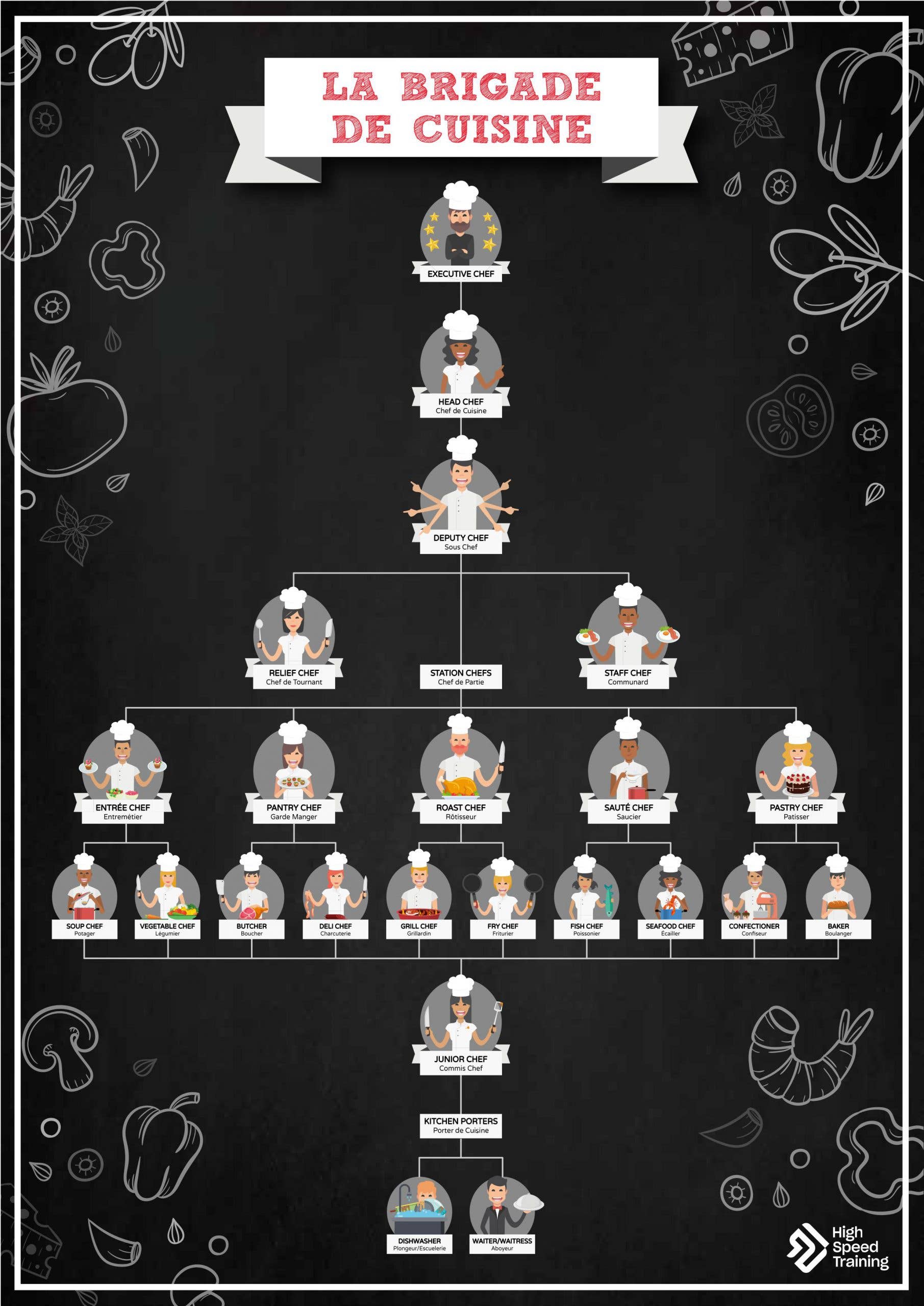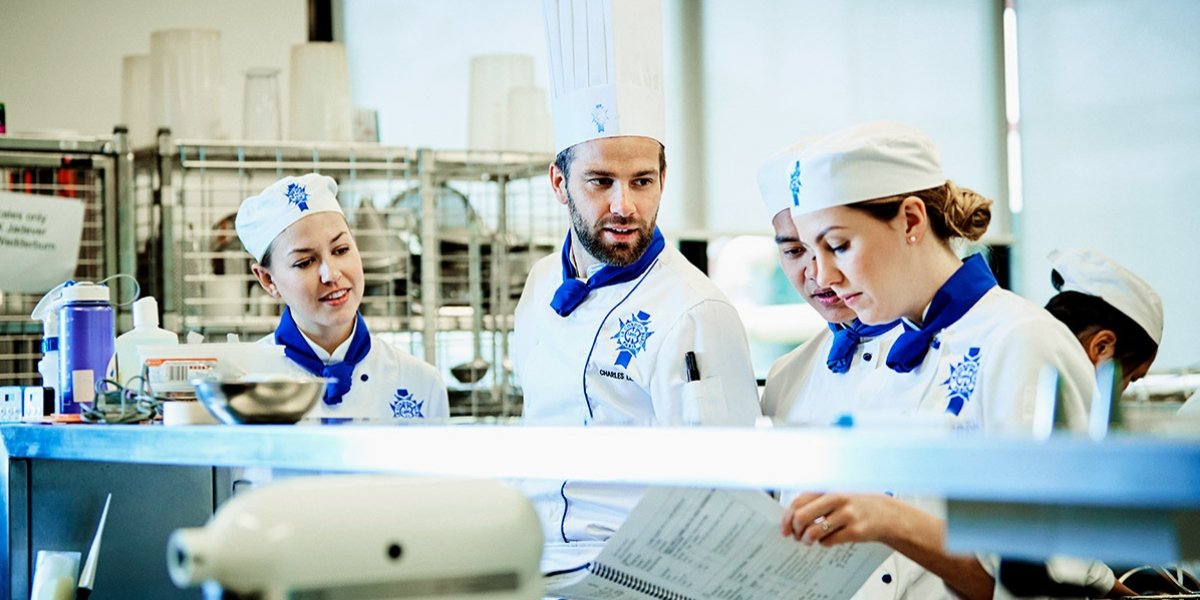A kitchen brigade is an organized system of staff in a restaurant kitchen, where each team member has a specific role and responsibility. The brigade system was first developed in France in the 19th century by Georges Auguste Escoffier, a renowned French chef. The brigade system is now used in many restaurants around the world and is designed to ensure efficient and effective service in the kitchen. It includes a chef de cuisine, sous chef, saucier, pastry chef, garde manger, and other cooks, each playing a specific role in the production and plating of food.
Definition of a Kitchen Brigade
A kitchen brigade is a system of management used in the restaurant industry to organize a kitchen staff. It was created by Georges Auguste Escoffier, a 19th-century French chef. The kitchen brigade system is based on a hierarchy of roles and responsibilities, with the head chef at the top and each kitchen staff member responsible for a specific task. Each station in the kitchen is staffed by a professional cook who is responsible for the preparation and cooking of the dishes assigned to that station. This system is designed to ensure that all areas of the kitchen are organized and efficient.
The kitchen brigade system is still the most common system used in restaurants today. It enables a high level of coordination and communication between the kitchen staff, ensuring that all areas of the kitchen are running smoothly and efficiently. It also allows chefs to ensure that the food is prepared and cooked to the highest standards and that all food safety regulations are met. The kitchen brigade system is an invaluable tool for any kitchen staff and is essential for any professional restaurant.
The History of a Kitchen Brigade
The kitchen brigade system is a hierarchical structure of kitchen staff that has been used in professional culinary establishments since the 19th century. The brigade system was developed by Auguste Escoffier to organize the kitchen staff into specialized roles and to ensure that each staff member was responsible for a specific set of duties. The brigade system is also known as the brigade de cuisine or the brigade system of culinary organization.
At the top of the brigade system is the chef de cuisine, who is responsible for the overall functioning of the kitchen. This person sets the menu, oversees the kitchen staff, and is the final authority on all matters related to the kitchen. Under the chef de cuisine are several sous-chefs, who are responsible for different sections of the kitchen, such as the cold kitchen, the hot kitchen, and the pastry kitchen. Each sous-chef is in charge of all the staff in his or her section and is responsible for the quality of the dishes served in that section.
In addition to the sous-chefs, there are other staff members in the kitchen brigade, including the commis de cuisine, who is the most junior member of the kitchen staff and is responsible for helping the sous-chefs with their duties. The kitchen brigade also includes the pantry chef, the garde manger, the butcher, and the chef de partie, who are all responsible for different areas of the kitchen.
The Different Roles of a Kitchen Brigade
The kitchen brigade is a term used to describe the organized hierarchy of personnel in a professional kitchen. The kitchen brigade is usually headed by the executive chef and includes a variety of other positions such as the sous chef, pastry chef, line cooks, and other kitchen staff. Each of these roles has its own specific responsibilities, and it is the job of the executive chef to ensure that each individual is performing their duties to the best of their abilities. The kitchen brigade is responsible for the overall success of a restaurant, as it is the team that works together to create the meals that the customers enjoy.
The executive chef is in charge of the entire kitchen staff and is responsible for ensuring that everyone is working together efficiently. The sous chef assists the executive chef and is often responsible for organizing the daily tasks in the kitchen. Line cooks are responsible for preparing the food according to the recipes and instructions of the executive chef. The pastry chef is responsible for creating the desserts and other pastries for the restaurant. Other kitchen staff may include dishwashers, prep cooks, and pantry staff.
Advantages of Using a Kitchen Brigade
A kitchen brigade is a hierarchical structure used in restaurants and commercial kitchens to maintain order and streamline kitchen operations. It is made up of various specialized roles, such as the chef de cuisine, sous chefs, and line cooks. Each role has specific responsibilities that must be fulfilled in order for the kitchen to run efficiently and effectively. The advantages of using a kitchen brigade system are numerous. It can help reduce costs by eliminating the need for multiple chefs and streamlining tasks such as food preparation and service. It also allows for better communication between staff members and the kitchen manager, increasing efficiency and ensuring that all tasks are completed on time. Additionally, a kitchen brigade system can help to increase customer satisfaction as it allows for more consistent quality of food. Finally, kitchen brigade systems can improve job satisfaction among staff members by providing structure and a clear chain of command.

Disadvantages of Using a Kitchen Brigade
The kitchen brigade system is a popular kitchen management structure used in restaurants, hotels, and other food service establishments. It was created by the French chef Auguste Escoffier in the 19th century and is based on a hierarchical arrangement of various kitchen positions. While the kitchen brigade system can be an effective way to manage a kitchen, it also has its disadvantages.
One of the major drawbacks of using the kitchen brigade system is the cost. It can be expensive to recruit and train staff for each position within the kitchen brigade, and the structure requires a great deal of management oversight. Furthermore, the system can be inflexible and slow to adapt to changing customer demands.
Another disadvantage of using the kitchen brigade system is its reliance on a team approach to cooking, which can stifle the creativity of individual chefs. Furthermore, the system does not always promote cooperation between staff, as each position is responsible for a specific task. Additionally, the system can be difficult to implement in large kitchens, as it requires a great deal of coordination between multiple staff members.
Finally, the kitchen brigade system requires a significant amount of time and resources to maintain. It can be difficult to keep track of individual kitchen tasks and staff performance, and the system can require a great deal of paperwork and administrative duties.
Training Requirements for a Kitchen Brigade
A kitchen brigade is a professionalized system of running a kitchen that is based on a strict hierarchy. It is a team-based approach that uses a division of labor to maximize efficiency and effectiveness in the kitchen. To work in a kitchen brigade, various training requirements must be met. First, a culinary degree is recommended, or at least a few years of experience in the food industry. Then, depending on the type of restaurant, specific certifications may be necessary to work in the kitchen. For example, some restaurants may require certifications such as ServSafe or the American Culinary Federation (ACF). Finally, kitchen brigade members should possess a strong knowledge of food safety, knife handling, and kitchen safety. They should also be knowledgeable in the specific types of cuisine served by the restaurant. By meeting these training requirements, kitchen brigade members can ensure that they are prepared to work efficiently and safely in the restaurant’s kitchen.
Trends in Kitchen Brigade Management
The kitchen brigade system is a traditional organizational structure for managing the various tasks and responsibilities in a professional kitchen. At its core, the system assigns each staff member a specific role, and the team works together to ensure that all tasks are completed efficiently and successfully. As the culinary industry continues to evolve, so do the trends in kitchen brigade management. Newer technologies, such as cloud-based software and automation, have enabled chefs to better manage their brigade and streamline their workflow. Additionally, chefs are now more likely to experiment with different organizational structures to find the one that best fits their kitchen’s needs. Furthermore, the use of social media, such as Instagram and YouTube, has enabled chefs to share their successes and challenges with a larger audience, leading to increased collaboration within their brigade. Ultimately, modern kitchen brigade management is about finding the right balance between efficiency, creativity, and collaboration.
Conclusion
The kitchen brigade is a system of organization for kitchen staff. It is a hierarchical structure that consists of a head chef, chef de cuisine, sous chef, and other station chefs. The kitchen brigade system is an efficient way to manage a kitchen staff, as it ensures that everyone is on the same page and knows what their responsibilities are. It also promotes communication between the different levels of kitchen staff, allowing them to work together to create the best dishes possible.


